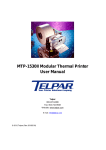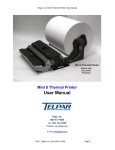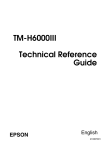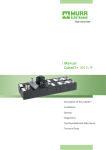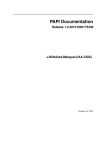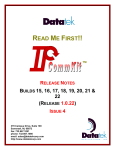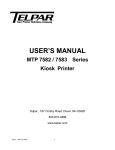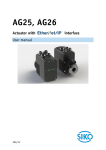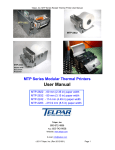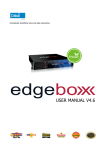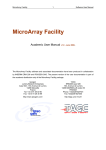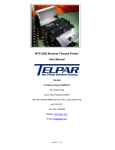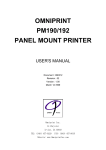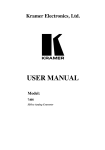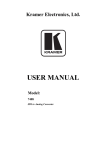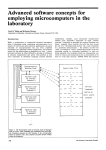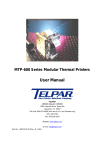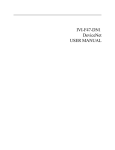Download MTP-1500 Modular Thermal Printer User Manual
Transcript
MTP-1500 Modular Thermal Printer User Manual TELPAR A Platinum Equity COMPANY 187 Crosby Road Dover, New Hampshire 03820 Toll Free: 800-872-4886 (from the U.S.A. and Canada only) 603-750-7237 Fax: 603-742-9938 Website: www.telpar.com E-mail: [email protected] Part No. 090103-0010 (Rev. B - 05/03) Page 1 of 64 Warranty Telpar — Printer Limited Warranty For one (1) year after shipment of the printer product to Buyer, Telpar warrants the product against defects in materials and workmanship provided the product has been operated and maintained in accordance with manufacturer’s operating and maintenance specifications. This warranty specifically excludes ribbons, paper and other consumable items. THIS WARRANTY IS IN LIEU OF ANY AND ALL OTHER WARRANTIES, EXPRESSED OR IMPLIED. TELPAR MAKES NO OTHER WARRANTY AND BUYER SPECIFICALLY WAIVES ANY OTHER WARRANTIES, INCLUDING WARRANTIES OF MERCHANTABILITY OR FITNESS FOR A PARTICULAR PURPOSE. THERE ARE NO WARRANTIES THAT EXTEND BEYOND THOSE DESCRIBED HEREIN. Telpar’s liability hereunder is limited to the repair or replacement of defective parts. This liability does not extend to normal wear and tear. Telpar will, solely at its option, remedy all valid warranty claims either by: (a) Repairing or replacing the defective unit at Telpar’s factory; or (b) Repairing or replacing the defective subassembly at Telpar’s factory. If so directed by Telpar, Buyer shall return the defective unit or subassembly, transportation prepaid by Buyer, to Telpar’s factory. After repair or replacement has been accomplished, Telpar will return the unit or subassembly, transportation prepaid by Telpar, to Buyer. As a precondition to any warranty service, prior to return of any units or subassemblies to Telpar by Buyer, Buyer must contact Telpar’s Order Administration Services and receive authorization in the form of a Return Material Authorization (RMA) number. Telpar reserves the right to refuse any goods it has not previously authorized for return, or any goods shipped without transportation prepaid. No warranty shall apply to any damage resulting from or caused by Buyer, if Buyer shall make any changes, modifications, additions or deletions of hardware, software or firmware in the Printer products sold hereunder without Telpar’s advance written consent. Upon receiving an RMA from Telpar, warranty service may be obtained by returning the merchandise, freight prepaid, with a copy of your invoice to: Telpar 187 Crosby Road Dover, New Hampshire 03820 U.S.A. ATTN.: Warranty Service Department. Telephone: 800-872-4886 or 603-750-7237 Fax: 603-742-9938 Email: [email protected] Upon inspection, Telpar will make necessary repairs or replacement and return the merchandise, shipping prepaid. Page 2 of 64 Table of Contents 1 General................................................................................................................................... 9 1.1 Definitions........................................................................................................................ 9 1.1.1 Standard Mode versus Page Mode............................................................................. 9 1.1.2 Hex Dump Mode.......................................................................................................... 9 1.1.3 Explanation of Terms used throughout this manual................................................. 11 1.2 Applications.................................................................................................................... 11 1.3 Standard Features......................................................................................................... 12 1.4 Options for the MTP-1500 Series................................................................................ 13 1.5 Specifications................................................................................................................. 13 1.6 Power Supply Requirements....................................................................................... 13 1.6.1 Voltage: 24 VDC ±10%............................................................................................. 13 1.6.2 No requirement for external 5 VDC power supply..................................................... 13 1.6.3 3-Pin Hosiden Connector on Printer for Power Supply Connection......................... 13 1.7 2 Telpar Roll Paper for MTP-1500 Series...................................................................... 14 Operator Instructions....................................................................................................... 15 2.1 Unpacking and Inspection............................................................................................ 15 2.2 Paper Loading................................................................................................................ 15 2.2.1 Side-Loading Roll...................................................................................................... 15 2.2.2 Black Mark Sensors Load......................................................................................... 15 2.3 Paper Jam....................................................................................................................... 17 2.3.1 3 Installation........................................................................................................................... 19 3.1 4 Head Open Lever...................................................................................................... 17 Self Test Mode............................................................................................................... 19 Interface Specifications................................................................................................... 21 4.1 4.1.1 General........................................................................................................................... 21 Setting of DIP Switches and MEMORY Switches..................................................... 21 Page 3 of 64 4.1.2 LEDs and Error Indication......................................................................................... 23 4.2 Control Codes and Control Sequences List.............................................................. 24 4.3 Control Codes and Control Sequences Definition................................................... 27 4.3.1 General Usage Print Commands.............................................................................. 27 4.3.2 Status Commands.................................................................................................... 31 4.3.3 Bar Code Commands............................................................................................... 31 4.3.4 Counter Commands.................................................................................................. 32 4.3.5 Top of Form Commands........................................................................................... 34 4.3.6 Page Mode Commands............................................................................................ 34 4.3.7 NV Memory and Down Load Bit Images Commands............................................... 36 4.3.8 Seldom Used Commands......................................................................................... 38 4.4 Descriptions of Commands.......................................................................................... 41 4.4.1 Set Print Mode........................................................................................................... 41 4.4.2 Set Bit Image Mode................................................................................................... 41 4.4.3 Set Raster Bit Image Mode....................................................................................... 43 4.4.4 Status Commands.................................................................................................... 44 4.4.5 Enable/Disable Auto Status Back (ASB) mode........................................................ 45 4.4.6 Status Bytes Transmitted.......................................................................................... 45 4.4.7 Bar Code Command................................................................................................. 46 4.4.8 GS k +m +n +d1 dn [1D 6B +m +n (DATA)]............................................................ 47 4.5 Serial (RS232C) Interface............................................................................................. 49 4.5.1 Serial (RS232C) Interface Specification................................................................... 49 4.5.2 Serial I/O Connector.................................................................................................. 49 4.5.3 Flow Control.............................................................................................................. 50 4.6 Centronics Parallel (IEEE-1284) Interface.................................................................. 51 4.6.1 5 Parallel I/O Connector............................................................................................... 51 Specifications..................................................................................................................... 53 Page 4 of 64 5.1 Features.......................................................................................................................... 53 5.2 General Specifications +++ redo................................................................................ 54 5.3 Character Sets............................................................................................................... 55 5.3.1 Overview.................................................................................................................... 55 5.3.2 PC437 U.S.A., Standard Europe Character Set....................................................... 56 5.3.3 Katakana Character Set............................................................................................ 57 5.3.4 PC850 (Multilingual) Character Set........................................................................... 58 5.3.5 PC860 (Portuguese) Character Set.......................................................................... 59 5.3.6 PC863 Canadian French Character Set................................................................... 60 5.3.7 PC865 Nordic Character Set.................................................................................... 61 5.3.8 WPC 1252 Character Set......................................................................................... 62 5.3.9 PC866 Cyrillic #2 Character Set............................................................................... 63 5.3.10 PC852 Latin 2 Character Set.................................................................................... 64 5.3.11 PC858 Euro Character Set....................................................................................... 65 5.3.12 Space Page Character Set....................................................................................... 66 5.3.13 Overseas Character Set........................................................................................... 67 5.3.14 International Character Set........................................................................................ 68 5.4 Dimensional Drawings of MTP-1530 (80 mm) Version.............................................. 69 5.4.1 Dimensional Drawing of MTP-1530 (80 mm) Version.............................................. 69 5.4.2 Dimensional Drawings of MTP-1532 (82.5 mm) Version......................................... 70 Page 5 of 64 List of Figures Figure 1 Print Sample.................................................................................................................... 10 Figure 2 Hex Dump of Print Sample............................................................................................ 10 Figure 3 3-Pin Hosiden Power Supply Connector....................................................................... 13 Figure 4 Black Mark Specifications.............................................................................................. 16 Figure 5 - MTP-1500 with Cutter Mechanism closed.................................................................... 17 Figure 6 - MTP-1500 with Cutter Mechanism open...................................................................... 18 Figure 7 MTP-1500 Self Test Printout.......................................................................................... 20 Figure 8 Counter Commands...................................................................................................... 33 Figure 9 Print Mode Settings........................................................................................................ 41 Figure 10 Status Commands....................................................................................................... 44 Figure 11 Fourth Status Byte Transmitted................................................................................... 46 Figure 12 - Serial I/O Connector +++ redo as DE9P.................................................................... 49 Figure 13 - Parallel I/O Connector +++ Change dwg to CENT............................................ 51 Figure 14 Overview of Character Sets......................................................................................... 55 Figure 15 PC437 U.S.A., Standard Europe Character Set........................................................... 56 Figure 16 Katakana Character Set (80-FF hex)............................................................................ 57 Figure 17 PC850 Multilingual Character Set................................................................................. 58 Figure 18 PC860 Portuguese Character Set............................................................................... 59 Figure 19 PC863 Canadian French Character Set....................................................................... 60 Figure 20 PC865 Nordic Character Set........................................................................................ 61 Figure 21 WPC 1252 Character Set............................................................................................. 62 Figure 22 PC866 Cyrillic#2 Character Set.................................................................................... 63 Figure 23 PC852 Latin 2 Character Set........................................................................................ 64 Figure 24 PC858 Euro Character Set.......................................................................................... 65 Figure 25 Space Page Character Set.......................................................................................... 66 Page 6 of 64 List of Tables Table 1 Current Requirements..................................................................................................... 13 Table 2 - DIP Switch 1 (DSW1) Settings...................................................................................... 21 Table 3 - DIP Switch 2 (DSW2) Settings +++ rearrange in order................................................ 22 Table 4 Control Codes and Control Sequences........................................................................... 26 Table 5 List of Control Codes and Control Sequences Locations................................................ 27 Table 6 General Usage Print Commands.................................................................................... 30 Table 7 Response to Status Commands.................................................................................... 31 Table 8 Status Commands......................................................................................................... 31 Table 9 - Bar Code Commands.................................................................................................... 32 Table 10 Top of Form Commands................................................................................................ 34 Table 11 – Page Mode Commands.............................................................................................. 36 Table 12 – NV Memory Commands.............................................................................................. 37 Table 13 - Seldom Used Commands........................................................................................... 40 Table 14 Set Bit Image Mode........................................................................................................ 41 Table 15 Set Raster Bit Image Mode............................................................................................ 43 Table 16 First Status Byte Transmitted........................................................................................ 45 Table 17 Second Status Byte Transmitted................................................................................... 45 Table 18 Third Status Byte Transmitted....................................................................................... 46 Table 19 Bar Code Commands.................................................................................................... 46 Table 20 Bar Code Command Values.......................................................................................... 47 Table 21 - Serial (RS232C) Interface Specification..................................................................... 49 Table 22 - Serial (RS232C) Interface Pin Assignments............................................................... 50 Table 23 - Parallel Interface Pin Assignments.............................................................................. 52 Table 24 - General Specifications................................................................................................. 54 Table 25 - Default Character Set.................................................................................................. 66 Table 26 - Overseas Character Set.............................................................................................. 67 Page 7 of 64 Table 27 - International Character Set.......................................................................................... 68 Page 8 of 64 1 General The MTP-1500 series of modular thermal printers is designed specifically for the high performance, size and durability requirements of cut and drop applications. The compact size and high performance characteristics, coupled with its rugged design also make it ideal for the kiosk environment. Four models make up the MTP-1500 Series: · MTP-1530-SF - 80 mm (3.15 in) paper width , Full Cut . (Part # 901033-0006) · MTP-1530 -SP - 80 mm (3.15 in) paper width , Partial Cut. (Part # 901034-0006) · MTP-1532 -SF – 82.5 mm (3.25 in) paper width , Full Cut. (Part # 901033-0010) · MTP-1532 -SP – 82.5 mm (3.25 in) paper width , Partial Cut. (Part # 901034-0010) 1.1 1.1.1 Definitions Standard Mode versus Page Mode Standard mode means printing data as it is received like most serial mode printers. If data is not received fast enough to keep the printer busy, the printer will print data it has received and then stop and wait for more data to be received so it can print a little more. This is the most commonly used mode of operation but anytime the printer has to stop and then restart, there is a possibility of reduced print quality. · Page mode means that all the data to be printed on a page is received before printing begins so once the printing process starts, an entire page is printed at full speed. · Most commands and parameters are the same for both standard mode and page mode but the ESC SP, ESC 2, and ESC 3 are set independently in standard mode and page mode, See section 4.2 Control Codes and Control Sequences List . · Some commands apply only to page mode and some commands are ignored in page mode. See Table xxx +++ add bookmark to COMMAND LIST table. · Ladder bar codes can be printed only in page mode. 1.1.2 Hex Dump Mode This function is sometimes useful for diagnosis of application programs when the printer does not perform as expected. In hex dump mode, the printer prints the hexadecimal code for each character received rather than processing the data as printable text and as control commands. The exception is that DLE EOT (real time STATUS request) and DLE ENQ (Real time request to printer) are executed as received even in hex dump mode. The hexadecimal notation is printed at 10 characters per line on the left side of the page and the printable characters (when possible) are printed on the right side of the page. Control codes print as periods on the right side section of the printout to help locate specific areas of the message to see what codes were actually received by the printer. After all data has been sent to the printer, pressing the paper feed button will flush the buffer and print the last line of data received. Hex dump mode is initiated in any of three ways: 1) Open the platen, hold the paper feed button down, turn on power, then close the platen and release the paper feed button. 2) Set DIP switch DPSW2 position 5 ON and then turn on power. 3) Send the appropriate GS ( A command. On entering hex dump mode, the printer prints a 4 line header “Hexadecimal Dump”, a blank line, “To terminate hexadecimal dump”, “press FEED three times.” Hex dump mode is terminated by 1) pressing the paper feed button three times in quick succession or 2) by turning DIP switch DPSW2 position 5 OFF and turning power back on. Print Sample Figure 1 Print Sample Page 9 of 64 Figure 2 Hex Dump of Print Sample 1.1.3 Explanation of Terms used throughout this manual Receive buffer – Receives data from the host and stores the data temporarily until it can be processed to the print buffer or processed as otherwise required. Print buffer – Stores the image data to be printed. Start of line – There is no print data in the print buffer and the print position is not specified by ESC $ or ESC \. Many commands are effective only at the start of line. Printable area – In standard mode the length in the horizontal direction is: 80 mm (640 dots per line/8 dots per mm) for the 82.5 mm paper width version, 72 mm (576 dots per line/8 dots per mm) for the 80 mm paper width version. In page mode the length in the horizontal direction is: 80 mm (640 dots per line/8 dots per mm) for the 82.5 mm paper width version, 72 mm (576 dots per line/8 dots per mm) for the 80 mm paper width version. In page mode the length in the vertical direction is: 83 mm (664 dots per line/8 dots per mm) for the 82.5 mm paper width version, 92 mm (738 dots per line/8 dots per mm) for the 80 mm paper width version. Printing area – Printing range set by command. The printing area must be less than or equal to the printable area. MBS – Most Significant Bit of a byte of data. LBS – Least Significant Bit of a byte of data. OFF LINE – There is no switch for setting the printer On Line or Off Line. The printer automatically goes Off Line a. From power on (or reset through the I/O connector) until the printer is ready to receive data. b. During self test. c. While feeding paper with the paper feed button. d. When out of paper. e. When the print platen is open. f. During a macro execution and in standby status. g. When an error occurs. 1.2 Applications · · Parking ticket dispensing Automated Teller Machines (ATMs) Page 10 of 64 · · Gaming receipts Interactive media kiosks 1.3 Standard Features · · · · · · · · · · · · · · Direct thermal printing Interfaces: Serial (RS232) and parallel (IEEE1284) . Paper widths - specified at time of order: Model MTP-1530 : 80 mm (3.15 in) Model MTP-1532 : 82.5. mm (3.25 in) Full or Partial Cut – specified at time of order. All metal construction Adjustable paper low sensor Paper auto load function ESC/POS [1] The commands conform to ESC/POS, which is a standard in the distribution industry. Print speed of up to 150 mm/sec (5.9 in/sec); 1200 dot lines/second) DIP switches accessible without removing cover. Paper capacity : 152 mm (6 in) diameter roll with 50 mm diameter core Overall size including 152 mm (6 inch) diameter roll of paper : 185.67 mm x 149.45 mm x 243.17 mm(7.31 in H x 5.88 in W x 9.57 in D) · Inverted print mode · Character code tables: PC437 (USA, default), Katakana, PC850 (Multilingual), PC860 (Portuguese), PC863 (Canadian-French), PC865 (Nordic), WPC1252, PC866 (Cyrillic2), PC852 (Latin2), PC858 (Euro), Space page. · International character set : Control Boards, have the following: U.S.A., France, Germany, England, Denmark (2 choices), Sweden, Italy, Spain (2 choices), Japan , Norway, Latin America, Korea. · Barcode embedded symbologies: UPC-A , UPC-E, JAN(EAN) 13, JAN(EAN)8 , 3 of 9 , ITF , CODABAR, Code93, and Code128 . Ladder Bar codes can be printed when using Page Mode. · Bit image mode · Reverse video mode · Underline printing · Continuous roll paper · Page Mode · Two character font sizes. Each can be printed from 1 to 8 times normal width and/or 1 to 8 times normal height. · “Smoothing” command (see GS b) – applies only in Page mode. 1.4 · · Options for the MTP-1500 Series ® ® Microsoft Windows driver. [2] Black Mark sensing. 1.5 Specifications · · · · · · · · · Resolution : 8 dots/mm (203 dots/in). Paper thickness : 0.056 mm to 0.15 mm maximum (0.0022 in to 0.0059 in). o o o o Operating temperature : 0 C to 55 C (32 F to 131 F). o o o o Storage temperature : -25 C to 70 C (-13 F to 158 F). Operating humidity : 10-85% RH (non-condensing). Peak current for head drive is 14A at 150 mm/second. Weight : Standard configuration without paper +++ kg (+++ lbs.). Expected life of mechanism: 15 million lines. Expected life of cutter: 1 million cuts. 1.6 Power Supply Requirements 1.6.1 Voltage : 24 VDC ±10% Current Requirements Page 11 of 64 High Speed Mode 14 Amps peak Divided Energy Mode 11.5 Amps peak Stand-by 0.1 Amps Table 1 Current Requirements 1.6.2 9 Amps average 7 Amps average No requirement for external 5 VDC power supply The 5 VDC for logic is supplied from the 24 VDC, by a regulator internal to the printer. 1.6.3 3-Pin Hosiden Connector on Printer for Power Supply Connection Figure 3 3-Pin Hosiden Power Supply Connector Page 12 of 64 1.7 Telpar Roll Paper for MTP-1500 Series Thermal sensitive coating is on the “inside” of the roll. · For MTP-1530 ;152 mm (6 in) outside diameter, 80 mm (3.15 in) wide, length 180 m (590 ft) P/N 251103-8006. · For MTP-1532 :152 mm (6 in) outside diameter, 82.5 mm (3.25 in) wide, length 180 m (590 ft) - P/N 2511038206. Specific to Thermal Printers: Telpar, Inc. does not warranty damages to the thermal print head as a result of printing with thermal paper not specified or approved by Telpar, Inc. 2 Operator Instructions 2.1 Unpacking and Inspection Carefully unpack and inspect your MTP-1500 for any damage that may have occurred in transit. Should any damage have occurred, notify Telpar, Inc., save the shipping carton and packing materials , and file a damage claim with the carrier. Specify the nature and the extent of the damage. Before installing or operating the printer, check the following: Printer mechanism and paper path are clear of all packing materials or other foreign matter. Paper is installed. DO NOT OPERATE the printer without paper. Refer to Section 2.2 - Paper Loading page 15 for paper loading instructions. 2.2 2.2.1 Paper Loading Side-Loading Roll The MTP-1500 series printer is configured as a side-loading printer . Slide roll of paper over spindle with paper fed under the bottom toward paper slot (front of unit). To load paper , turn on the power and feed the straight edge of the paper into the paper guide. AUTOLOAD will automatic load paper once it is fed into the paper guide. Once paper has been initially loaded, the paper feed button may be used. Ensure that the paper is installed correctly and feeding properly with the thermal side facing up. 2.2.2 Black Mark Sensors Load The MTP-1500 series printer may be used with the optional Black Mark Sensor. This requires the use of a pre-printed Top of Form (TOF) Mark or Black Mark on the form. Dip switch SW1 position 1 must be set to the ON position to enable black mark operation. If DIP switch DSW1 position 1 is turned on to enable the Black Mark sensor when the printer is loaded with plain paper, at Power On the printer will feed about 17.5 inches of paper looking for a Black Mark and then go to an error mode since it did not find a Black Mark. To load paper , turn on the power and feed the straight edge of the paper into the paper guide. Ensure that the paper is installed correctly and feeding properly with the thermal side facing up. If using perforated paper, the perforation should be fed at least 1.27 mm (0.05 in) past the cut line to avoid a jam at the cutter. The black mark may extend across the full width of the paper. (TBD) See Figure 4 Black Mark Specifications See section 4.3.5 Top of Form Commands Page 13 of 64 NEED NEW DRAWING Figure 4 Black Mark Specifications See section 4.3.5 - Top of Form Commands for additional information. 2.3 Paper Jam In the event of a paper jam condition do not force paper into the unit, or try to pry the paper out of the unit, this may damage the thermal print mechanism . Caution should be exercised when working next to the cutter mechanism , the blades are sharp and may cause serious injury. To release paper: Turn off power to the printer. Push the Head Open lever to the down position. (See Figure 6 - MTP-1500 with Cutter Mechanism open ) Paper can be removed at this time. Once paper is cleared from the mechanism, return the Head Open lever to the up position. 2.3.1 Head Open Lever The Head Open lever is located at the left front of the printer mechanism. The up position is ready to print. The down position lifts the print head off of the platen roller for manually inserting paper or for clearing a paper jam. The down (head open) position signals the microprocessor that the head is open so that no printing will occur. Figure 6 - MTP-1500 with Cutter Mechanism open 3 Installation 3.1 Self Test Mode The MTP-1500 has a self-test mode that will print and cut a sample ticket. To place the unit into self-test mode , first turn power switch off, then press and hold the FEED push button switch and place the POWER switch in the ON position.. Release the switch after printing starts.See Figure 7 MTP-1500 Self Test Printout on page 20 . The first part of the self test message prints several fields showing how the printer is configured. Following the first part of the self test, you have the option of pressing the paper feed button to print a “barber pole” pattern print test or turning power off and back on to terminate the self test The printer goes to the off-line Page 14 of 64 (BUSY) state when self test starts and remains off-line until self test is finished due two either of these actions. All electrical/mechanical portions of the printer are exercised and checked by this action, except for the serial interface or parallel interface components. Figure 7 MTP-1500 Self Test Printout 4 Interface Specifications 4.1 General The MTP-1500 Series includes a Serial RS232 interface and a IEEE1284 Parallel interface. Page 15 of 64 4.1.1 Setting of DIP Switches and MEMORY Switches 4.1.1.1 DSW1 – DIP Switch Item DIP Switch 1 (DSW1) Settings Bit No Setup status Setup state Serial-interfacecommunication baud rate setting Even/odd parity selection Parity use selection Serial interface handshaking Bit 8 8,7 Bit 7 OFF OFF ON OFF OFF ON ON ON 6 OFF 5 4 OFF OFF ON ON ON Interface Selection Black Mark sensor 3,2 1 Bit 3 OFF Bit 2 OFF Setup before shipping 38400 bps 19200 19200 bps 9600 bps 4800 bps Odd parity No parity DTR/DSR control Xon/Xoff control Even parity Parity used Parallel interface ODD No Parity DTR Parallel OFF ON ON,OFF Disabled Disabled Enabled Serial interface Add to table for 3,2 Optional? Either,ON Table 2 - DIP Switch 1 (DSW1) Settings Page 16 of 64 4.1.1.2 DSW2 – DIP Switch 2 DIP Switch 2 (DSW2) Settings Bit Setup Status Setup State No. Item Parallel I/O pin 31 = RESET 8 OFF ON Serial I/O pin 6 = RESET 7 OFF ON Factory use Operation mode selection Print density selection 6 5 OFF ON 3,4 Bit 3 Bit 4 ON ON OFF OFF ON OFF OFF ON Printer mechanism 1, 2 Bit 1 Bit 2 selection OFF OFF ON OFF OFF ON ON ON Table 3 - DIP Switch 2 (DSW2) Settings Setup before shipping OFF No reset Reset signal on pin 31 No reset OFF Reset signal on pin 6 OFF Normal Normal Hex Dump Normal Slightly light Normal Slightly dark Dark As required for mech MTP-1532 MTP-1530 60 mm 58 mm 4.1.1.3 There are 8 MEMORY Switches, only two are currently used Memory Switch 1 Function ON Auto line feed enabled (Parallel interface only) OFF Auto line feed disabled #4 ON Receive error is ignored (serial interface only) OFF Receive error prints “?” (serial interface only) #3 ON BUSY condition when buffer is full OFF BUSY when buffer is full or when OFF-LINE Memory Switch 8 Position Function #4 ON Cutter is NOT installed OFF Cutter is installed #3 ON Reverse paper feeding is enabled (See NOTE) OFF Reverse paper feeding is disabled #1 ON Divided energy print mode OFF High speed print mode Note: Not all printer mechanisms allow reverse paper feeding. If reverse feeding is allowed, after cutting the paper with a GS V command, paper feeds backwards. The print starting position adjustment with GS ( F can be set to the backward direction relative to the cutting position. In this case, the maximum backward feed length is 14 mm (112 * 0.125mm). Position #5 4.1.2 LEDs and Error Indication Three LEDs (D3, D5, and D6) are located above Dip switch DSW1. Page 17 of 64 D3 is the green POWER LED, ON means power is stable and the printer is ready for operation. OFF means power in not stable. D5 is a red PAPER OUT LED, OFF means paper is installed and the printer is ready for operation. ON means there is no paper installed in the printer mechanism (or the paper low sensor if selected). The PAPER OUT LED blinks steadily to specify that self test has finished the first part of printing and that the user can press the PAPER FEED button to print the “barber pole” character print part of the self test. The PAPER OUT LED also blinks steadily to specify that a MACRO is waiting for the user to press the PAPER FEED button to continue it’s execution (macro standby mode). D6 is a red ERROR LED. OFF means there are no errors and the printer is ready for operation. ON indicates the printer is OFF LINE (except during paper feeding using the FEED button, during self-test printing, and in the error state). The ERROR LED blinks a defined pattern every 5.12 seconds to notify the user of various error conditions. When the LED is normally OFF and blinks ON, an error is indicated which may be recoverable. . When the LED is normally ON and blinks OFF, an error is indicated which in not recoverable. For any error that is not recoverable, power should be turned off as soon as possible. Blink Rate Error Description Recovery method Continuous Print head The temperature Automatic when the Temperature has exceeded 70 print head cools off. degrees C 1 blink ON Cutter error The cutter has Recovers by DLE failed to complete ENQ after the cutter a cut Jam has been corrected 1 blink OFF PCB error The printer Turn power off and mechanism is not check connections connected or the between the printer internal wiring in mechanism and the incorrect. controller board. 2 blinks ON Black Mark No Black Mark Recovers by DLE ENQ. within ???. was detected 2 blinks OFF R/W error The CPU has Cycle power off and detected a on to see if the memory R/W error error goes away. 3 blinks OFF High voltage The power supply Turn power OFF, voltage is too high correct the problem before turning back on. 4 blinks OFF Low voltage The power supply Turn power OFF, voltage is too low. correct the problem before turning back on. 5 blinks OFF CPU error A program Cycle power off and execution error on to see if the error goes away. 6 blinks ON Platen open The Print platen is Recovers by DLE open ENQ after the platen is closed. 4.2 HT LF FF Control Codes and Control Sequences List Horizontal tab Print and line feed PAGE MODE, print and return to standard mode Location of Definition General General PAGE Class Execute Execute Execute Page 18 of 64 Standard mode Yes Yes Ignored Page mode Yes Yes Yes Black Mark mode, print and feed to print starting position (Black Mark) CR Print and carriage return CAN Cancel print data DLE EOT Real time status request DLE Real time request to printer ENQ ESC Escape sequence header FS FS sequence header GS GS sequence header ESC FF Print data ESC SP Set right side character spacing ESC ! Set print mode(s) ESC$ Set absolute print position ESC % Select/cancel user-defined character set ESC & Define user-defined characters ESC * Select bit image mode ESC Turn underline on/off ESC 2 Select default line spacing ESC 3 Set line spacing ESC ? Cancel user-defined characters ESC @ Initialize printer ESC D ESC E ESC G ESC J ESC L ESC M ESC R Set horizontal tabs Turn emphasized on/off Turn double-strike on/off Print and feed paper Select PAGE MODE Select character font Select international character set ESC S Select standard mode ESC T Select print direction ESC V Turn rotated print on/off ESC W Set printing area ESC \ Set relative print position ESC a Select justification ESC c 3 Select paper sensors to output paper out signal ESC c 4 Select paper sensors to stop printing ESC c 5 Enable/disable panel buttons ESC d Print and feed n lines ESC t Select character code table ESC { Turn inverted print on/off FS p Print NV bit image FS q Define NV bit image GS FF Feed paper to Black Mark General, Top of Form Execute Yes Disabled General PAGE STATUS General Execute Execute Execute Execute Yes Ignored Yes Yes Yes Yes Yes Yes ------PAGE General ------Execute Setting ------Ignored Yes ------Yes Yes General General, PAGE Seldom Setting Execute Setting Yes Yes Yes Yes Yes Yes Seldom Setting Yes Yes General General General General Seldom Execute Setting Setting Setting Setting Yes Yes Yes Yes Yes Yes Yes Yes Yes Yes General Yes Yes General General General General PAGE General General Execute, Setting Setting Setting Setting Execute Execute Setting Setting Yes Yes Yes Yes Start line Yes Yes Yes Yes Yes Yes Ignored Yes Yes PAGE PAGE General PAGE General, PAGE General General Execute Setting Setting Setting Execute Setting Setting Ignored Value Yes Value Yes Start line Yes Yes Yes Value Yes Yes Value Yes General Setting Yes Yes General Setting Yes Yes General General General NV & DL NV & DL Top of Form Execute Setting Setting Execute Setting Execute Yes Yes Start line Yes Start line Yes Yes Yes Value Disabled Disabled Yes Page 19 of 64 GS ! GS $ GS * GS ( A GS ( E GS ( F GS ( M GS / GS : GS B GS C 0 GS C 1 GS C 2 GS C ; GS E GS H Select character size Set absolute vertical print position Define download bit image Execute test print User setup commands Set adjustment values Customize printer control values Print download bit image Start/end macro definition General PAGE Setting Execute Yes Ignored NV & DL General Seldom Setting Execute Execute, Setting Setting Setting Yes Yes Yes Ignored Start line Disabled Execute Execute, Setting Setting Setting Setting Setting Setting Setting Setting Empty Yes Seldom Seldom NV & DL Seldom Yes Yes Yes Yes Start line Value Yes Yes Set reverse video on/off General Yes Yes Select counter print mode Counter Yes Yes Select count mode (A) Counter Yes Yes Set counter Counter Yes Yes Select count mode (B) Counter Yes Yes Select head control method Seldom Yes Yes Select printing position of Bar Code Yes Yes HRI characters GS I Transmit printer ID Status Execute Yes Yes GS L Set left margin General Setting Start line Value GS T Set print position to General Execute Yes Ignored beginning of line GS V Select cut mode and cut General Execute Start line Yes paper GS W Set printing area width General Setting Start line Value GS \ Set relative vertical printing PAGE Execute Ignored Yes position GS ^ Execute macro Seldom Execute Yes Yes GS a Enable/disable Auto Status Status Execute, Yes Yes Back (ASB) Setting Yes GS b Turn smoothing mode Setting Yes on/off GS c Print counter Counter Execute Yes Yes GS f Select font for HRI Bar Code Setting Yes Yes characters GS h Set bar code height Bar Code Setting Yes Yes GS k Print bar code Bar Code Execute Empty Yes GS r Transmit status Status Execute Yes Yes GS v 0 Print raster bit image General Execute Empty Disabled GS w Set bar code width Bar Code Setting Yes Yes Table 4 Control Codes and Control Sequences List of Control Codes and Control Sequece Locations Control Codes Control Sequences Bar Code See 4.3.3 Bar Code Commands page 31 Counter See 4.3.4 Counter Commands page 32 General See 4.3.1 General Usage Print Commands page27 NV & DL See 4.3.7 NV Memory and Down Load Bit Images Commands page 36 Page See 4.3.6 Page Mode Commands page 34 Seldom See 4.3.8 Seldom Used Commands page 38 Status See 4.3.2 Status Commands page 31 Page 20 of 64 Top of Form See 4.3.5 Top of Form Commands page 34 Disabled Parameters will be processed as normal data. Empty Enabled only when at the beginning of a line. Ignored Command code and parameters are ignored. Start line Enabled only when there is no data in the print buffer Yes Function is enabled. Table 5 List of Control Codes and Control Sequences Locations 4.3 Control Codes and Control Sequences Definition 4.3.1 General Usage Print Commands Name Tab Line feed Form feed General Usage Print Commands Description Command Command (hex) ASCII +n = data byte[hex] HT 09 Move the print position to the next horizontal tab position. Default is a TAB position every 8 columns. See ESC D. LF 0A Print data and feed paper. Default line spacing = 3.75mm. See ESC 2 and ESC 3 FF 0C See Top of Forms Commands. CR CR 0D Real-time request to printer DLE ENQ +n 10 05 +n ESC FS GS Set right side character spacing ESC FS GS ESC (SP) +n 1B 1C 1D 1B 20 +n Set Print mode ESC ! +n 1B 21 +n Page 21 of 64 See Page Mode Commands. If parallel interface is selected and automatic line feed is is enabled (Memory Switch 1-5) then CR is treated as LF. See LF. +n=01hex, Recover from error and restart printing from the line where the error occurred. +n=02hex, Recover from an error after clearing the receive and print buffers. ESC Sequence Header FS Sequence Header. GS Sequence Header. Set spacing to the right of each character to n x 0.125 mm (n x 0.0049”). Doubled for Double Wide. Does not affect the Kanji character set. Set values independently in Page and Normal modes. Set Print mode. See Section 4.4.1 - Set Print Mode. See ESC M, ESC E, ESC -, GS!. ESC $ +n 1B 24 n m Current print position is set +m to (n + m x 256) x 0.125 mm from the beginning of the line. See ESC \, GS $, GS\. See Page mode. ESC \ +m 1B 2A +m Set Bit Image mode. See +n1 +n2 +n1 +n2 4.4.2. - Set Bit Image Mode +d1 dn (data) ESC - +n 1B 2D +n n=0 (00 or 30 hex) Turn underline off. n=1 (01 or 31 hex) Turn on 1 dot line high underline. n=2 (02 or 32 hex) Turn on 2 dot line high underline. See ESC !. ESC 2 1B 32 Set 3.75 mm line spacing (30 dot lines). See ESC 3. ESC 3 +n 1B 33 +n Set single line spacing to n dot lines (n x 0.125mm). Set independently in Page and Normal mode. Default = 30. See ESC 2. ESC @ 1B 40 Resets the printer to the mode it was in when power was turned on. Clears the data in the print buffer but does not the data in the receive buffer. The DIP switches and MEMORY switches are not rechecked. The MACRO definition is not cleared. ESC D 1B 44 Set from 1 to 32 tab +d1 dn (DATA) 00 positions. Data values NUL range from 1 to 255 in ascending order. If a data value is less than the previous data value, this command is terminated. NUL terminates this command when less than 32 TAB positions are being set. ESC D NUL clears all tab positions. Default is every 8 columns. ESC E +n 1b 45 +n LSB = 0 Turn emphasized mode off. LSB = 1 Turn emphasized mode on. See ESC !. ESC G +n 1B 47 +n LSB = 0 Turn double strike mode off. LSB = 1 Turn double strike mode on. Printout is the same as emphasized. See ESC E. Set absolute print position Select Bit Image mode Turn underline mode on/off Set default line spacing Set Line feed pitch Printer reset Set Horizontal Tab positions Turn emphasized mode on/off Turn double-strike mode on/off Name Command Command Description Page 22 of 64 +n = data byte[hex] ESC J +n 1B 4A +n Print if needed then feed Forward paper feed for paper n dot lines. Range n dot lines = 0 to 255dec. If BM is enabled, this command can feed paper past the mark. Select ESC M +n 1B 4D +n n=0 (00 or 30 hex) selects character font FontA (12x24). n=1 (01 or 31 hex) selects FontB (9x17). See ESC ! ESC R +n 1B 52 +n Select international Select International character set. See Section character set 5.3.14 – International Character Set +++ reprint section Rotate print ESC V +n 1B 56 +n n = 1 (01 or 31 hex) Rotate the print 90 degrees clockwise. n = 0 (00 or 30 hex) Cancel the rotation. Rotated characters do not get underlined. Double wide becomes double high and double high becomes double wide. Not Page mode. See ESC ! and ESC -. Set relative ESC \ +n 1B 5C n m Set printing to current print position +m print position + (n+(m*256)). Ignored if specified setting exceeds the printable area. See Page mode. Select ESC a +n 1B 61 n n=0 (0 or 30 hex) Left justification justify. n=1 (01 or 31 hex) Center justify. n=2 (02 or 32 hex) Right justify. Normal mode only, must be received at the start of a line. See HT, ESC $, and ESC \. Select paper ESC c 3 +n 1B 63 33 Bit 1 enables or disables sensors to +n the paper low sensor. Bit output paper 3 enables or disables the end status paper out sensor. A value of 1 enables and a value of 0 disables. Applies to the parallel interface ONLY. Select paper ESC c 4 +n 1B 63 34 Setting bit 0 or bit 1 high sensor to stop +n causes the Paper Low printing sensor to be used as a Paper Out sensor. Panel buttons ESC c 5 +n 1B 63 35 LSB = 0 Paper feed enable/disable +n button is enabled. LSB = 1 Paper feed button is disabled. During a macro ASCII Page 23 of 64 instruction standby the feed button is always enabled but will not feed paper. Print if needed then feed paper n character lines. Range = 0 to 255dec. Maximum amount of paper fed = 1016 mm (40”). Can feed past marks in BM mode. See section 5.3 Character Sets Forward line feed for n character lines ESC d +n 1B 64 +n Select Character code table Set/Reset Inverted print ESC t +n 1B 74 +n ESC +n 1B 7B +n LSB = 1, upside-down printing. LSB = 0, normal printing. This command must be received at the start of a line to be in effect for that line. Does not apply in page mode. 1D 21 +n Characters can be printed in sizes from 1 to 8 times normal in either width or height. Bits 0, 1, and 2 set the character width multiplier. Bits 4, 5, and 6 set the character height multiplier. A value of 0 = Normal size. Does not apply to HRI characters when printing bar codes. See ESC !. 1D 28 41 n = 0 or 1 or 2 (00, 01, 02 00 +n 02, 30, 31, or 32 hex). +m m=1 (01 or 31 hex) causes a Hexadecimal dump print pattern. ). m=2 (02 or 32 hex) causes a Printer Status print pattern. m=3 (03 or 33 hex) causes a “barber pole” print pattern. Must be received at the start of a line. A cut is performed following the print test. The printer is reset following the print test, even download characters or bit image are erased. 1D 42 +n Bit 0 = 0 (default) turns off and bit 0 = 1 turns on reverse video printing. Does not apply to bit image, user-defined bit image, bar codes and the HRI part of bar codes, or spaces skipped by HT, ESC $, or ESC \ Select GS ! +n character size Test print GS ( A 02hex 00hex +n +m Reverse video GS B +n Page 24 of 64 commands. Does not affect the space between character lines. Underline does not apply while reverse video is enabled. Set left margin GS L +n +m 1D 4C +n Set the left margin to dot position m x 256+n. Must +m be received at the start of a line. Does not apply in Pase mode. See GS W. Set print GS T +n 1G 54 +n n=0 (either 00 or 30hex) position to the sets the print position to beginning of the start of the print line print line after deleting data in the print buffer. n=1 (either 01 or 31hex) sets the print position to the start of the print line after printing data in the print buffer. Cut command GS V m 1D 56 +m If m = 1 (either 01hex or +n 31hex) a cut is performed and the +n byte must not be sent. If m is a capital B (42hex) then paper is fed for n dot lines and then a cut is performed. GS W +n Set Right 10 57 +n Sets the print width to m x Margin +m +m 256 + n relative to the left margin. Must be received at the start of a line. See GS L. Print raster bit GS v 0 +m 1D 76 30 See 4.4.3 - Set Raster Bit image +x1 +x2 +y1 m x1 x2 y1 Image Mode +y2 +data y2 data Table 6 General Usage Print Commands Page 25 of 64 4.3.2 Status Commands Because some of the bits in the status responses are fixed, the user can confirm the command to which the status belongs and differentiate the status responses from XON/XOF as shown: Response to Status Commands Response to Bit Pattern GS r 0xx 0xxxx XON 00010001 XOF 00010011 DLE EOT 0xx 1xx10 ASB (1st byte) 0xx 1xx00 nd th ASB 2 -4 0xx 0xxxx Table 7 Response to Status Commands The transmit buffer is 99 bytes long. If more than 99 bytes are stored up without being transmitted, the status bytes that have no place to be stored will be thrown away. Status Commands Name Command Command+n = Description data byte[hex] ASCII Real-time STATUS DLE EOT +n 10 04 +n See Section 4.4.4 - Status request Commands . Transmit printer ID GS I +n 1D 49 +n See Section 4.4.4 - Status Commands . Enable/disable GS a +n 1D 61 +n See Section 4.4.4 - Status Automatic Status Commands . Back (ASB) Table 8 Status Commands 4.3.3 Bar Code Commands Name Bar Code Commands Command Command ASCII Select print position GS H n for HRI characters Select font for HRI GS f +n Set Bar code height GS h +n Print bar code GS k +n Description +n = data byte[hex] 1D 48 +n n = 0 (either 00hex or 30hex), no HRI printed. n = 1 (either 01hex or 31hex), HRI printed above the bar code. . n = 2 (either 02hex or 32hex), HRI printed below the bar code. n = 3 (either 03hex or 33hex), HRI printed both above and below the bar code. The font used is specified by GS f. Default = 0. 1D 66 +n n = 0 (either 00hex or 30hex), print the HRI using FontA (12x24). n = 1 (either 01hex or 31hex), print the HRI using FontB (9x17). Default = 0. 1D 68 +n Set the bar code height in dots. Default = 162. Range = 1 to 255dec. 1D 6B +n (data) Selects the bar code type and Page 26 of 64 (data+ NUL 00 Set bar code width GS w +n 1D 77 +n prints. See Section 4.4.7 - Bar Code Command . n defines the width of lines used for printing bar codes in mm. For codes Code39, ITF, and CODABAR: n=2, 0.250 & 0.625. n=3, 0.375 & 1.000. n=4, 0.500 & 1.250. n=5, 0.625 & 1.625. n=6, 0.750 & 2.000. For codes UPC-A, UPC-E, JAN13, JAN8, Code93, and CODE128; the smaller number listed above = the Modulo Width. Default = 3. Table 9 - Bar Code Commands 4.3.4 Name Counter Commands Command Counter Commands Command Description ASCII +n = data byte[hex] Select GS C 0 +n +m 1D 43 30 +n counter print +m mode n = 00 hex, prints the actual digits indicated by the number value. n = 01 hex through 05 hex sets the number of digits to be printed. m=0 (either 00 hex or 30 hex), align right with leading spaces. m=1 (either 01 hex or 31 hex), align right with leading zero. m=2 (either 02 hex or 32 hex), align left with trailing spaces. If n = 0 then m has no meaning. Default is n=m=0. Select count GS C 1 +n1 1D 43 32 +n1 n1+n2*256 = start count. mode (A) +n2 +m1 +m2 +n2 +m1 +m2 m1+m2*256 = end count. n = step +n +r +n +r amount. r = the repetition number when the counter value is fixed. Count up mode is set when n1+n2*256 < m1+m2*256 and n and r are not =0. Count down mode is set when n1+n2*256 > m1+m2*256 and n and r are not =0. Counting stops when n1+n2*256 = m1+m2*256 and n and r are not =0. n = the amount to increment the count by. R = the repetition number when counter value is fixed. Set counter GS C 2 +n1 1D 43 32 +n1 n1+n2*256 sets the value of the +n2 +n2 serial number counter. In count-up mode; if the counter value goes outside the counter operation range set by GS C 1 or GS C ;, it is forced to convert to the minimum value set by GS c. In count-down mode; if the counter value goes outside the counter operation range set by GS Page 27 of 64 Select count GS C ; s1 ; s2 1D 43 3B s1 mode (B) ; s3 ; s4 ; s5 ; 3B s2 3B s3 3B s4 3B s5 Print counter GS c 1D 63 C 1 or GS C ;, it is forced to convert to the maximum value set by GS c. s1 through s5 are all character strings made up of the ASCII characters 0 through 9. s1 and s2 range from 0 to 65535 and s3 through s5 range from 0 to 255. s1 and s2 specify the counter range. s3 = the amount to increment the count by. S4 = the repetition number when the counter value is fixed. s5 = the counter value. Count-up mode is selected by s1 < s2 and s3 and s4 are not =0. . Count-down mode is selected by s1 > s2 and s3 and s4 are not =0. Counting stops when s1 = s2 or s3 = 0 or s4 = 0. Sets the serial counter value in the print buffer and increments or decrements the counter value based on the count mode selected by GS C 0 and either GS C 1 or GS C ;. In count up mode the counter value is set to the minimum value if it goes out of the range set by GS C 1 or GS C ;. In count down mode the counter value is set to the maximum value if it goes out of the range set by GS C 1 or GS C ;. Figure 8 Counter Commands Page 28 of 64 4.3.5 Top of Form Commands Name Command ASCII Form feed FF Feed to Black GS FF Mark Top of Form Commands Description Command +n = data byte[hex] 0C 1D 0C Print if needed then feed paper to the next Black Mark if the BM sensor is enabled. See GS ( F, GS FF, and DSW1 position 1). Feed paper to the next Black Mark position. Ignored unless enabled by Dip SW 1 position 1. See GS ( F, FF) and Dip Switch settings. Table 10 Top of Form Commands For additional information black mark sensing, see Section 2.2.2 Black Mark Sensors Load . 4.3.6 Page Mode Commands Name Command ASCII Bar Code Commands Description Command Form feed FF +n = data byte[hex] 0C CAN CAN 18 Print data in ESC FF Page mode 1B 0C Set absolute ESC $ +n +m 1B 24 n m print position Select Page ESC L mode 1B 4C Print and return to standard mode. Printed data is cleared from the data buffer. The printing area set by ESC W is reset to the default setting. See ESC FF, ESC L, and ESC S Cancel print data in page mode. See ESC L and ESC W. Prints all buffered data in the printing area. Printed data is not cleared from the data buffer. ESC T and ESC W values are not cleared. See FF, ESC L, and ESC S. In Page mode with the starting position (See ESC T) set to the top left corner or the bottom right corner this is a horizontal position but with the starting position set to the top right corner or the bottom left corner this is a vertical position. See ESC \, GS $, GS\. Must be received at the start of a line. Settings of ESC SP, ESC 2, ESC 3 have independent values in page mode and standard mode. ESC V, ESC a, ESC {, GS L, and GS W while in page mode makes the settings for standard mode but have no affect while in page mode. The printer returns to standard mode at power on, reset, or ESC @ Page 29 of 64 Select standard mode Select print direction In page mode, set printing area Set relative print position Page mode, Set absolute vertical print position Page mode, set relative vertical print position received. See FF, CAN, ESC FF, ESC S, ESC T, ESC W, GS$, GS \. ESC S 1B 53 Data buffered in page mode is cleared. The printing area set by ESC W is initialized. Settings of ESC SP, ESC 2, ESC 3 are switched to the standard mode values. See FF, ESC FF, ESC L. ESC T +n 1B 54 +n Sets the position where data is buffered within the printing area set by ESC W. n=0 (either 00 hex or 30 hex) sets the starting position to the upper left corner and printing goes from left to right. n=1 (either 01 hex or 31 hex) sets the starting position to the lower left corner and printing goes from bottom to top. n=2 (either 02 hex or 32 hex) sets the starting position to the lower right corner and printing goes from right to left. n=3 (either 03 hex or 33 hex) sets the starting position to the upper right corner and printing goes from top to bottom. ESC W +x1 1B 57 +x1 +x2 x1+x2*256 = horizontal starting +x2 +y1 +y2 +y1 +y2 +dx1 position. y1+y2*256 = vertical +dx1 +dx2 +dx2 +dy1 starting position. dx1+dx2*256 = +dy1 +dy2 +dy2 printing area width. dy1+dy2*256 = printing area height Defaults are x1=x2=y1=y2=0, dx1=128 for 82.5 mm printer or 64 for 80 mm printer, dx2=2, dy1=152 for 82.5 mm printer or 226 for 80 mm printer, dy2=2. ESC \ +n +m 1B 5C +n +m Set printing position to current position plus (n+m*256)*0.125 mm. If the starting position is set (by ESC T) to the upper left or lower right of the printing area then the offset is in the horizontal direction but if the starting position is set to the upper right or lower left of the printing area then the offset is in the vertical direction. GS $ +n +m 1D 24 +n +m Sets the absolute vertical starting position to buffer character data to (n+m*256)*0.125 mm referenced to the starting posotopn defined by ESC T. If the starting position is set (by ESC T) to the upper left or lower right of the printing area then the position is in the vertical direction but if the starting position is set to the upper right or lower left of the printing area then the position is in the horizontal direction. GS \ +n +m 1D 5C +n +m Set printing position to current position plus (n+m*256)*0.125 mm positive (down the page) or 65536(n+m*256)*0.125 mm negative (up Page 30 of 64 Turn smoothing mode on/off GS b +n 1D 62 +n the page). If the starting position is set (by ESC T) to the upper left or lower right of the printing area then the offset is in the vertical direction but if the starting position is set to the upper right or lower left of the printing area then the offset is in the horizontal direction. LSB = 0 turns smoothing off. LSB = 1 turns smoothing on. Smoothing applies to built-in or user defined characters when printed at any size larger than the normal. See ESC !, GS !. Table 11 – Page Mode Commands 4.3.7 NV Memory and Down Load Bit Images Commands A download bit image is stored in RAM and is cleared by a power cycle or by the commands ESC @ or ESC &. A download bit image (GS *) and user defined characters (ESC &) can not be defined simultaneously, defining either will cancel the other. An NV bit image is stored in non-volatile memory and is cleared only by redefining the NV bit image message. Frequent writes may damage the NV memory. Maximum recommended usage is 10 times per day. Bar Code Commands Name Description Command Command +n = data byte[hex] FS p +n +m 1C 70 +n +m Print the NV message +n defined by FS q in the resolution specified by +m. m = 0 (either 00 hex or 30 hex = 203 by 203 density. m = 1 (either 01 hex or 31 hex = 203 V by 102 H density. m = 2 (either 02 hex or 32hex = 102 V by 203 H density. m = 3 (either 03 hex or 33 hex = 102 V by 102 H density. Must be received when the print buffer is empty. Is not affected by print modes (emphasized, double strike, underline, character size, reverse video. rotated, etc) but is affected by upside-down printing mode. Data which exceeds the allowable print width of the printer is ignored. This command is ignored in Page mode. FS q +n +x1 1C 71 +n +x1 +n (1 through 255) defines the +x2 +y1 +y2 +x2 +y1 +y2 number of NV bit images to be (data) 01 hex (data) 01 hex stored in memory. For each NV bit through +x1 through +x1 image (x1+x2*256)*8 = number of +x2 +y1 +y2 +x2 +y1 +y2 dots being defined in the horizontal (data) n hex (data) n hex direction and (y1+y2*256)*8 = number of dots being defined in the vertical direction. Each NV bit image is terminated with a sequential number n. x1 and y1 can range from 0 through 255, x2 can range from 1 through 3, y2 can range from 0 through 1, but ASCII Print NV image Define NV image – Page 31 of 64 Define GS * +x +y download bit (data) image 1D 2A +x +y (data) Print GS /+m downloaded bit image 1D 2F +m x1+x2*256 can not be less than 1 or greater than 1023 and y1+y2*256 can not be less than 1 or greater than 288. The amount of data needed to complete this command is (x1+x2*256)*(y1+y2*256)*8 bytes. Each bit image stored requires an additional 4 bytes for header information. A total of 192 Kbytes is available for storage of all NV bit images. This command clears all previously stored NV bit images so to write a new NV bit image requires reloading all NV bit images which are to be stored. When this command is completed, the printer performs a hardware reset so all user-defined characters, downloaded bit images, and macros are cleared and all functions are the same as if power was turned off then back on. In standard mode this command must be received at the start of a line. This command does nothing in page mode. See drawing +++ add bookmark. (Rick) +x (1 to 255dec) defines the horizontal size as x times 8 dots. +y (1 to 48dec) defines the vertical size as y times 8 dots. x times y cannot exceed 1536. The download bit image is cleared by a power on reset, ESC @, or ESC &, (a download bit image (GS *) and user defined characters (ESC &) can not be defined simultaneously, defining either will cancel the other). See drawing +++ add bookmark. (Rick) Print the downloaded bit image defined by GS * in the resolution specified by +m. m = 0 (either 00hex or 30hex = 203 by 203 density. m = 1 (either 01hex or 31hex = 203 V by 102 H density. m = 2 (either 02hex or 32hex = 102 V by 203 H density. m = 3 (either 03hex or 33hex = 102 V by 102 H density. Must be received when the print buffer is empty. Is not affected by print modes (emphasized, double strike, underline, character size, reverse video. rotated, etc) but is affected by upside-down printing mode. If the downloaded bit image exceeds the printable area, the excess data is not printed. If the margins have been set by the GS L and/or GS W commands, this Page 32 of 64 command will readjust the margins as required to print as much of the data as possible for the printer mechanism being used. In Page mode, the terms horizontal and vertical depend on the print starting position defined by ESC T. Table 12 – NV Memory Commands ***+++ Add drawing showing data structure for both download bit image and NV bit image. (Rick) 4.3.8 Name Seldom Used Commands Command ASCII Set/cancel ESC % +n user-defined character set Seldom Used Commands Description Command +n = data byte[hex] 1B 25 n LSB of n = 0 (default) selects ROM character generator. LSB of n = 1 selects User Defined character generator. See ESC & and ESC ?. Define User- ESC & +y +c1 1B 26 03 +c1 +y specifies 3 bytes per character in defined +c2 (+x +data) +c2 (data) the vertical direction. +c1 specifies characters the first character to be downloaded and +c2 specifies the last character to be downloaded. +x specifies the number of dots in the horizontal direction. The value of +x is 12dec for FontA or 09dec for FontB ). FontA or FontB are selected by ESC ! or ESC M. A download bit image (GS *) and user defined characters (ESC &) can not be defined simultaneously, defining either will cancel the other. See ESC %, ESC ?, +++ add dwg & bookmark. (Rick) Cancel user- ESC ? +n 1B 3F +n The previous user defined character defined pattern for character +n (20 hex characters through 7E hex in either font selected by ESC !) is cleared and the internal character generator is used to print the character n. See ESC & and ESC %. User-defined GS ( E +p1 1D 28 45 +p1 p1+p2*256 = the number of data commands +p2 +m (data) +p2 +m (data) bytes to follow +m plus 1. Function 1 enters the user defined mode. +m=01 hex, p1=03 hex, p2=00 hex, d1=49 hex, d2=4E hex. The printer transmits 37 hex 20 hex, 00 hex. Function 2 ends the user defined mode. +m=02 hex, p1=04 hex, p2=00 hex, d1=4F hex, d2=55 hex, d3=54 hex. The printer performs a software reset, m=2 is only effective Page 33 of 64 in the user defined mode. Function 3 allows setting of the memory switches. +m=03 hex, p1+p2*256 can vary from 10 dec to 65530 dec. The data structure is a 1 followed by b8 through b1. a1 (01 hex through 08 hex) specifies the memory switch to be changed. b8 represents position 8 of that memory switch and so on through b1 represents position 1 of that memory switch then another a followed by b8 through b1 can follow as specified by the values of p1 and p2. The values for each b are 30 hex to set a switch OFF, 31 hex to set a switch ON, or 32 hex to leave a switch unchanged. 32 hex should be sent for the “reserved” switches. The switch changes made become effective after a reset or power cycle. Running a self-test printout can check the switch settings. Frequent writes may damage the NV memory. Maximum recommended usage is 10 times per day. Set adjustment values GS ( F +p1 +p2 +a +m +n1 +n2 Function 4 causes the printer to transmit the settings of a memory switch. +m=04 hex, p1=02 hex, p2=00 hex. The data byte value is from )1 hex through 08 hex to specify which memory switch is being checked. The eleven data bytes transmitted are 37 hex, 21 hex, 8 data bytes representing the 8 switch positions, and 00 hex. The 8 data bytes are transmitted in the order of switch position 8 through switch position 1. For each switch position, the data sent will be 30 hex (an ASCII 0) if the switch is OFF or 31 hex (an ASCII 1) if the switch is ON. 1D 28 46 04 Effective only when the BM sensor 00 +a +m +n1 is enabled. +a = 01 hex selects the +n2 function for the position to start printing when used by FF or GS FF commands. +a = 02 hex selects the function for the position to start cutting when used by the GS V command. +m = 0 (either 00 hex of 30 hex) specifies a forward paper feed. +m = 1 (either 01 hex of 31 hex) specifies a reverse paper feed. (n1+n2*256)*0.125 mm specifies how much to feed. The default of all Page 34 of 64 Save or load GS ( M +p1 adjustment +p2 +n +m values in NV memory adjustment values is 0. 1D 28 4D +p1 Function 1 saves the settings made +p2 +n +m by GS ( F in NV memory. +n = 1 (either 01 hex or 31 hex), +m = 1 (either 01 hex or 31 hex), +p1=02 hex, +p2=00 hex. Function 2. +n = 2 (either 02 hex or 32 hex), +m = 0 (either 00 hex or 30 hex), setting made by GS ( F is set as the default value or +m = any value except either 00 hex or 30 hex, setting values are stored in area m of memory, +p1=02 hex, +p2=00 hex. Must be processed at the beginning of a line. No effect in page mode. Function 3 set whether or not the value saved in NV memory is the default to be used at power on. +n = 3 (either 03 hex or 33 hex). +m = 0 (either 00 hex or 30 hex), the printer does not load the value from NV memory at initialization. +m = any value except either 00 hex or 30 hex, the printer loads the value from NV memory at initialization. Start/end macro definition GS : Select head control method GS E +n Execute macro GS ^ +n +m +o Frequent writes may damage the NV memory. Maximum recommended usage is 10 times per day. 1D 3A Macro definition starts when this command is received during normal operation and ends when this command is received during macro definition. ESC @ does not clear the contents of the macro definition so ESC @ can be included in the macro definition. The contents of the macro can not exceed 2048 bytes. 1D 45 +n +n=00 hex, Print speed 1 (150 mm/second). +n=10 hex, Print speed 2 (100 mm/second). +n=20 hex, Print speed 3 (80 mm/second). +n=30 hex, Print speed 4 (50 mm/second). When Memory switch 8 position 1 is set to divided energy, the maximum speed is 120 mm/second. Default is speed 1. 1D 5E +n +m +n (0 through 255) specifies the +o number of times to execute the macro. +m (0 through 255) specifies how long to wait between executions of the macro (m*100 milliseconds) When the LSB on +o is 0, the macro executes n times at Page 35 of 64 the interval of m*100 msec. When the LSB on +o is 1, the macro executes then after an interval of m*100 msec the Paper Out LED flashes and the printer waits for the Paper Feed button to be pressed as a signal to execute the next sequence until the macro has executed +n times Table 13 - Seldom Used Commands Page 36 of 64 4.4 4.4.1 Descriptions of Commands Set Print Mode ESC ! +n +n is defined as: [1B 21 +n] Bit 7 Print Mode Settings 0 = Underline OFF Bit 6 Bit 5 1 = Underline ON. Not used. 0 = Double wide print OFF. Bit 4 1 = Double wide print ON. 0 = Double high print OFF. Bit 3 1 = Double high print ON. 0 = Emphasized print OFF. Bit 2 Bit 1 Bit 0 1 = Emphasized print ON. Not used. Not used. 0 = FontA (12x24). 1 = FontB (9x17). Figure 9 Print Mode Settings Both double wide and double high can be selected for any of the type faces. When a printed line contains characters with different heights, the characters are arranged so that bottoms of all characters line up. All characters printed can be underlined except 90 degree-rotated characters. The space caused by the tab command HT is not underlined. The thickness of the underline is defined by ESC – regardless of the character size. Default = 0hex (12 x 24 matrix).. 4.4.2 Set Bit Image Mode ESC \ +m +n1 +n2 +d1 dn [1B 2A +m +n1 +n2 (data)] Specifies and prints bit image graphics. Set Bit Image Mode +m Mode Vertical dot Horizontal Number of data density dot density bytes 00 hex 8 Single 67.7 dpi 101.6 dpi n1+n2*256 density 01 hex 8 Double density 67.7 dpi 203.2 dpi n1*n2*256 20 hex 24 Single 203.2 dpi 101.6 dpi (n1+n2*256)*3 density 21 hex 24 Double 203.2 203.2 dpi (n1+n2*256) density dpi Table 14 Set Bit Image Mode If +m is not one of the specified values, the rest of the ESC sequence is ignored and all information starting with +n1 is treated as normal data. In single density mode (+m=00 or 20), for each bit of data received the printer prints two dots horizontally so the horizontal resolution is 101.6 dpi. In double density mode (+m=01 or 21), for each bit of data received the printer prints one dot horizontally so the horizontal resolution is 203.2 dpi. In 8 dot mode (+m=00 or 01), for each data bit received the printer prints three dots vertically so the vertical resolution is 67.7 dpi. Page 37 of 64 In 24 dot mode (+m=20 or 21), for each data bit received the printer prints one dot vertically so the vertical resolution is 203.2 dpi. +n1 and +n2 define the number of dots per line to be printed in the horizontal direction. +n1 and +n2 cannot both have a value of 0. The range of +n1 = 0 to 255 dec and the range of +n2 is 0 to 3 dec so a total number of horizontal dot position which can be printed with one ESC sequence can vary from 1 to 1023.. If +n1 or +n2 is outside this range, the ESC sequence is ignored and all data following is treated as normal data. If the bit image data specified is more than what will fit on a line, the excess data is ignored. If the width of the printing area set by GS L and GS W is less than the width required by the data sent with the ESC * command, the margins are re-adjusted to print as much of the graphics data as possible. The right margin is extended first and then if the data still will not fit then the left margin is readjusted up to the point where the full width of the print head is used for printing the graphics image. When 8 dot bit image is selected, each byte of data represents 8 vertical dots to be printed. The MSB is the top dot to be printed and the LSB is the bottom dot to be printed. For each of the 8 bits within each data byte, a “1” represents a dot position to be printed and a “0” represents a dot position not to be printed. When 24 dot bit image is selected, each series of three bytes of data represent 24 vertical dots to be printed. The first byte represents the top 8 dots to be printed, the second byte represents the 8 dots to be printed in the middle, and the trird byte represents the bottom 8 dots to be printed. The MSB of each byte is the top dot to be printed and the LSB is the bottom dot to be printed. For each of the 24 bits within each series of three data bytes, a “1” represents a dot position to be printed and a “0” represents a dot position not to be printed. After printing a bit image, the printer returns to normal mode. The graphics mode is not affected by print modes (emphasized, double-strike, underline, character size, or reverse video) but is affected by the inverted print mode. Page 38 of 64 4.4.3 Set Raster Bit Image Mode GS v 0 +m +x1 +x2 +y1 +y2 +d1 dk [1D 76 30 +m +x1 +x2 +y1 +y2 (data)] Specifies and prints RASTER bit image graphics. Set Raster Bit Image Mode +m Mode Vertical dot Horizontal density dot density (RICK) 0 (00 or 30 hex) Normal 203.2 dpi 203.2 dpi 1 (01 or 31 hex) Double Wide 203.2 dpi 101.6 dpi 2 (01 or 32 hex) Double high 101.6 dpi 203.2 dpi 3 (03 or 33 hex) Quadruple 203.2 dpi 203.2 dpi Table 15 Set Raster Bit Image Mode The number of data bytes which must be sent to complete this command = (x1+x2*256)*(y1+y2*256). If +m is not one of the specified values, the rest of the ESC sequence is ignored and all information starting with +n1 is treated as normal data. The values of x1 and x2 select the number of data bytes (x1+x2*256) in the horizontal direction. The value of x1 can be from 1 to 128 and the value of x2 must be 00hex so the maximum number of dots which can be specified is 1024 (128 bytes times 8 bits per byte). Any data specified and received which exceeds the printing width of the printer is read in and then discarded. The values of y1 and y2 select the number of dot rows (y1+y2*256) in the vertical direction. The value of y1 can be from 0 to 255 and the value of y2 can be from 0 to 8 with the value of (y1+y2*256) being in the range of 1 through 4095. ??? does not compute? EPSON to specify In standard mode, this command is effective only when there is no data in the print buffer. The starting point of the printed image can be set by the HT (Horizontal Tab), ESC $ (Set absolute print position), ESC \ (Set relative print position), or GS L (Set left margin) command if that position is a multiple of 8. This command is not affected by print modes (character size, emphasized print, double strike, inverted print, underline, reverse video, etc.). ESC a (Select justification) is effective on raster bit images. If the width of the printing area set by GS L and GS W is less than the minimum width, the printing area is extended to the minimum width only on the line in question. This minimum width is 1 dot in normal or double high mode and is 2 in double wide or quadruple mode. Each data byte represents 8 horizontal dots to be printed with the MSB being to the left and the LSB being to the right. . For each of the 8 bits within each data byte, a “1” represents a dot position to be printed and a “0” represents a dot position not to be printed. The first x1+x2*256 data bytes are printed as the first raster line. The next x1+x2*256 data bytes are printed as the second raster line. This sequence continues until all y1+y2*256 dot lines defined have been printed. After printing the raster bit image, the printer returns to normal mode. 4.4.4 Status Commands Three commands pertain to status transmission: DLE EOT +n, GS I +n, and GS a +n. DLE EOT +n 10 04 +n Real-time STATUS request Status is transmitted immediately when this command is received without verifying that the host is ready to receive data. This command is executed even if the printer is off-line, the receive buffer is full, or there is an error status with a serial interface controller. With a parallel interface controller, this command cannot be executed when the printer is BUSY but is executed when the printer is OFF-LINE or in an error state if MEMORY switch 1-3 is on. Status will be transmitted even if a valid command string is received while receiving data as part of another command sequence (such a part of a bit image pattern). EPSON to answer ??? Check to see if the data is also then printed so the bit image pattern does not mess up everything afterward. This command must not be sent to the printer in the middle of any other multi-byte command sequence or this command will be interpreted as the remaining part of the multi byte command. Status Commands n= Action 01 hex Transmit Printer status. 02 hex Transmit Offline status. Page 39 of 64 03 hex 04 hex Transmit Error status. Transmit Paper roll status. Figure 10 Status Commands See section 0 - . Status Bytes Transmitted GS I +n 1D 49 +n Transmit printer ID +n=1 (01 or 31 hex) causes 24hex to be transmitted. +n=2 (02 or 32 hex) causes Type ID to be transmitted. Bit 2 = 1, BM sensor is enabled. Bit 1 = 1, Autocutter is installed. Bit 0 = 1, two-byte character code is supported. Bit 0 = 0, two-byte character code is not supported. +n=3 (03 or 33 hex) causes “Firmware Version” to be transmitted. GS a +n [1D 61 +n} Page 40 of 64 4.4.5 Enable/Disable Auto Status Back (ASB) mode Causes the printer to transmit four status bytes on the XD line when this command is processed out of the receive buffer and also sets the conditions which will cause the printer to automatically transmit the status bytes. If all conditions are disabled then the ASB function is also disabled. The status bytes are transmitted without checking to see if the host is ready to receive the data. +n is defined as: Enable/Disable Auto Status Back (ASB) mode Bit Function Bit 7 Not used. Bit 6 Not used. Bit 5 Not used. Bit 4 Not used. Bit 3 1 = enable ASB for paper out status Bit 2 1 = enable ASB for an error condition Bit 1 1 = enable ASB for Online/Offline. Bit 0 Not used – set to 0. Table 16 Enable/Disable Auto Status Back (ASB) mode See section 0 - . Status Bytes Transmitted . 4.4.6 Status Bytes Transmitted First Status Byte Transmitted The first byte sent due to Status byte sent when DLE EOT ASB status= printer 01hex is received information: Not used – always OFF Not used – always OFF. 1 = PAPER FEED button. Not used 1 = Platen is open. Not used. Not used – always ON. Not used – always ON. 1=OFF LINE, 0 = ON LINE. 1 = off-line, 0 = on-line. Not used - always ON. Not used – always ON. Bit 7 Bit 6 Bit 5 Bit 4 Bit 3 Bit 2 Bit 1 Not used - always OFF Not used – always ON Bit 0 Not used - always OFF. Not used – always OFF Table 17 First Status Byte Transmitted Second Status Byte Transmitted The second byte sent due to Status byte sent when DLE EOT ASB status = printer 02 hex is received information: Bit 7 Not used - always OFF Not used – always OFF Bit 6 1 = An automatically 1 = an error occurred, 0 = no errors. recoverable error has occurred (Print head temperature or Platen open). Bit 5 1 = An unrecoverable error has 1 = Printing is halted, 0 = not out of occurred. paper. Bit 4 Not used - always OFF. Not used – always ON. Bit 3 1 = CUTTER error. 1 = paper is being fed by the paper feed button. Bit 2 Not used Bit 1 Not used. 1 = Platen is open. Bit 0 Not used. Not used – always ON. Page 41 of 64 Table 18 Second Status Byte Transmitted Third Status Byte Transmitted The third byte sent due to Status byte sent when DLE EOT ASB status = paper sensor 03 hex is received information: Bit 7 Not used - always OFF Not used – always OFF Bit 6 Not used. 1 = an auto recoverable error has occurred (print head temperature or platen open). Bit 5 Not used. 1 = an un recoverable error has occurred. Bit 4 Not used - always OFF. Not used – always ON. Bit 3 1 = PAPER OUT 1 = a cutter error has occurred. Bit 2 1 = PAPER OUT 1 = a mechanical error has occurred. Bit 1 1 = PAPER LOW. Not used – always ON. Bit 0 1 = PAPER LOW Not used – always OFF Table 19 Third Status Byte Transmitted Fourth Status Byte Transmitted The fourth byte sent due to Status byte sent when DLE EOT ASB status = paper sensor 04 hex is received information: Bit 7 Not used – always OFF Not used – always OFF Bit 6 Not used. Bits 6 & 5 both 1 = paper out. Bit 5 Not used. Bits 6 & 5 both 1 = paper out. Bit 4 Not used – always OFF Not used – always ON. Bit 3 Not used Bits 3 & 2 both 1 = Paper low. Bit 2 Not used. Bits 3 & 2 both 1 = Paper low. Bit 1 1 = MEMORY switch 1-3 is Not used – always ON. ON Bit 0 Not used. Not used – always OFF Figure 11 Fourth Status Byte Transmitted 4.4.7 Bar Code Command GS k +m +d1 dn NUL [1D 6B +m (DATA) 00] For +m = 00hex through 06hex, +m selects the bar code type Bar Code Commands +m Bar Code No. of data bytes 00 hex UPC-A 11 or 12 01 hex UPC-E 11 or 12 02 hex JAN(EAN)13 12 or 13 03 hex JAN(EAN)8 7 or 8 04 hex CODE39 variable 05 hex I 2 of 5 06 hex CODABAR even number variable Valid data (ASCII) 0-9 0-9 0-9 0-9 0 - 9, A-Z, space, $ % + - . / 0-9 0 – 9, A,B,C,D, $ +-./: Table 20 Bar Code Commands Notes: 1. For UPC-A or UPC-E, Printing starts after 12 data bytes are received. 2. For JAN13 (EAN13), Printing starts after 13 data bytes are received. 3. For JAN8 (EAN8), Printing starts after 8 data bytes are received. 4. For ITF, the number of data bytes must be an even number. Page 42 of 64 GS k +m +n +d1 dn [1D 6B +m +n (DATA)] For +m = 41hex through 49hex, +m selects the bar code type, +n = number of data bytes to follow. Bar Code Command Values +m Bar Code +n(dec) Valid data = 41 hex UPC-A 11 or 12 0-9 42 hex UPC-E 11 or 12 0–9 43 hex JAN(EAN)13 12 or 13 0-9 44 hex JAN(EAN)8 7 or 8 0-9 45 hex CODE39 1 thru 255 0 - 9, A-Z, space, $ % + - . / 46hex I 2 of 5 even 1 thru 255 0 - 9 47hex CODABAR 1 thru 255 0 – 9, A,B,C,D, $+-./: 48hex Code93 1 thru 255 00hex thru 7Fhex 49hex Code128 2 thru 255 00hex thru 7Fhex Table 21 Bar Code Command Values Notes: 1. +n indicates the number of data bytes which follow. 2. If +n is outside the allowable range, the command aborts and following data is treated as normal data. Notes when CODE93 (+m=48hex) is used: 1. In the HRI fields, a small square is printed as the start character and as the stop character before and after the HRI character string. 2. In the HRI field, a small solid block followed by alphabetic character is printed when a control code is printed. The character printed after the block for each control code is (nn in hex,alphe character): 00,U 01,A 02,B 03,C 04,D 05,E 06,F 07,G 08,H 09,I 0A,J 0B,K 0C,L 0D,M 0E,N 0F,O 10,P 11,Q 12,R 13,S 14,T 15,U 16,V 17,W 18,X 19,Y 1A,Z 1B,A 1C,B 1D,C 1E,D 1F,E 7F,T.. Notes when CODE128 (+m=49 hex) is used: 1. The first character of the bar code data string must be the code set selection character (CodeA, CodeB, or CodeC) which selects the first code set to use. Code setcharacters are specified by sending a two character sequence, the first character is { (7B hex) and the second is a printable ASCII character. CodeA = {A, CodeB = {B, CodeC = {C. a. Code set A consists of the ASCII characters 00 hex through 5F hex, FNC1 through FNC4, SHIFT, CodeB, and CodeC. b. Code set B consists of the ASCII characters 20 hex through 7F hex, FNC1 through FNC4, SHIFT, CodeA, and CodeC. c. Code set C consists of 2-digit numeral characters using one character (100 numerals from 00 dec through 99 dec or 00 hex through 63 hex), FNC1, CodeA, and CodeB. 2. Special characters are specified by sending a two character sequence, the first character is { (7B hex) and the second is a printable ASCII character. The special characters are SHIFT and the FUNCTION characters. SHIFT = {S, FNC1 = {1, FNC2 = {2, FNC3 = {3, and FNC4 = {4. To specify the character { send {{. The usage of FUNCTION characters depends on the application program. 3. In code set A the character just after SHIFT is processed as a character for code set B. In code set the character just after SHIFT is processed as a character for code set C. In code set C the SHIFT is invalid. 4. HRI characters are not printed for the SHIFT characters or CODE SET selection characters. 5. HRI for a Function character is a space. 6. HRI for a control code (00hex through 1Fhex, and 7Fhex) is a space. 7. Errors in the data cause the bar code processing to abort, data following is treated as normal data. a. The top of the data field is not a code set selection character. b. If a sequence {+n is invalid. c. Characters that can not be used in special code set. Page 43 of 64 Notes in standard Mode: 1. If any invalid data is received, the printer only feeds paper and the following data is treated as normal data. 2. If the horizontal size exceeds the printing area, the printer only feeds paper. 3. This command only feeds enough paper to print the bar code regardless of ESC 2 and ESC 3 settings. 4. This command is valid only when there is no data in the print buffer. When there is data in the print buffer, the data following +m is treated as normal data. 5. This command is not affected by print modes (emphasized, double-strike, underline, character size, reverse video, or rotated print) but is affected by the inverted print mode. Notes in Page mode: 1. This command develops the bar code data in the print buffer. The print position moves to the right side dot of the bar code. 2. If any invalid data is received, the printer stops command processing and the following data is treated as normal data. The data buffer position does not change. 3. If the bar code width exceeds the printing area, the bar code is not printed but the data buffer position moves to the left side of the printing area. 4.5 4.5.1 Serial (RS232C) Interface Serial (RS232C) Interface Specification Item Data receive speed Synchronizing method Hand shake Input output level Signal level Serial (RS232C) Interface Specification Specification 38400, 19200, 9600, 4800 bps (set by DIP switch) Asynchronous, Full duplex DTR/DSR signal or XON/XOFF (set by DIP switch) RS232C Space (logic=0) +3 V +12 V Mark (logic=1) -3 V -12 V Table 22 - Serial (RS232C) Interface Specification 4.5.2 Serial I/O Connector Figure 12 - Serial I/O Connector +++ redo as DE9P Serial (RS232C) Interface Pin Assignments Pin Name Direction Function 2 RD I RS232 received data. 3 XD O RS232 transmitted data. 4 DTR O Hardware handshake line. 5 GND Logic ground. 6 DSR I High (“space”) = OK for the printer to transmit data when requested. The state of DSR is IGNORED for XON/XOF Page 44 of 64 handshaking if selected. Dip Switch SW2 position 7 ON reconnects this signal to be a hardware RESET input signal (normal connection to the DTR line from a computer will hold the printer always reset). 7 RTS O Same as DTR. Table 23 - Serial (RS232C) Interface Pin Assignments 4.5.3 Flow Control MEMORY switch 1 position 3 ON sets the BUSY condition when the receive buffer is full. OFF sets the BUSY condition when the receive buffer is full or when Off Line. The MTP-1500 employs a 4 K byte data buffer to allow the host computer to rapidly transfer data. Under some circumstances it may be possible to completely fill the buffer . When the Receive Buffer is within 128 bytes of being full, the MTP-1500 signals the host computer to pause until the receive buffer has room 256 bytes. The flow control information is sent to the host using hardware or software protocols as determined by the DIP switch settings. The hardware protocol uses the DTR line of the serial interface. This pin are asserted or negated as necessary to turn off and turn on the flow of data. The software protocol uses the XON (11hex) and XOFF (13hex) ASCII control codes which are sent back to the host to start and stop the data stream. When XON/XOF handshaking is enabled, the XON and XOF are transmitted without checking the state of the DSR line of the I/O connector. Some host systems may not support one or both of these protocols. If memory switch 1 position 3 is set to OFF and DTR handshaking is enabled, then the DTR line goes to the BUSY state whenever the printer is OFF LINE (see section 1.1.3 add bookmark) or when the receive buffer is full. If memory switch 1 position 3 is set to ON and DTR handshaking is enabled, then the DTR line goes to the BUSY state from the time power is turned on until the printer is ready to receive data, during self test, or when the receive buffer is full. If XON/XOF is enabled then the DTR line goes to the BUSY state from the time power is turned on until the printer is ready to receive data or during self test. If XON/XOF handshaking is enabled the printer sends XON when the printer goes On Line after a power on, when the receive buffer becomes available following a buffer full condition, when the printer switches from Off Line to On Line, or when the printer recovers from an error using DLE ENQ 1 or DLE ENQ 2. The printer sends XOF when the receive buffer becomes full or when the printerr switches from On Line to Off Line. 4.6 4.6.1 Centronics Parallel (IEEE-1284) Interface Parallel I/O Connector DB 25S, PC Pinout Figure 13 - Parallel I/O Connector +++ Change dwg to CENT ??? add definition of 1284 handshaking protocol Parallel Interface Pin Assignments Pin Name Nibble & Byte Direction Function mode 1 /STB HostClk I Active Low Pulse to send data tp printer 2 DO DO I/O ASCII data bit 0 (LCB) 3 D1 D1 I/O ASCII data bit 1 4 D2 D2 I/O ASCII data bit 2 5 D3 D3 I/O ASCII data bit 3 6 D4 D4 I/O ASCII data bit 4 Page 45 of 64 7 8 9 10 D5 D6 D7 /ACK D5 D6 D7 PtrClk I/O I/O I/O O 11 BUSY PtrBusy O 12 PE AckDataReq O 13 SLCT Xflag O 14 /AFXT HostBusy I 15 n/c ND 16 GND GND I 17 Fgnd FG 18 Logic-H Logic-H O 19 thru GND GND 30 31 /INIT /INIT I 32 /ERROR /DataAvail O 33 GND ND 34 DKSTAT ND O 35 +5V ND O 36 /SLCTIN 1284-Active I Table 24 - Parallel Interface Pin Assignments 5 Specifications 5.1 Features ASCII data bit 5 ASCII data bit 6 ASCII data bit 7 Active low pulse when data is accepted High level when printer cannot accept data. High level when printer is out of paper . Logic ground. . Logic ground. The MTP-1500 series uses an ultra high-speed line thermal printer driven by 24 VDC, printing on 80 mm (3.15 in) or 82.5 mm (3.25 in) width paper. · This printer is suitable for variety of application, such as POS terminals, ticket machines, coupon machines, label printers, medical instruments, and so on. · High speed printing : It can print at 150 mm/s (1200 dot line/s) max. Low power consumption: the peak current for head drive is only 14 A (at 150 mm/s printing speed). · Paper auto loading function : Thermal paper can be set without head-up lever operation by auto loading. · ESC/POS® *¹ Commands: These commands conform to ESC/POS™, which is a standard in the distribution industry. · Auto Cutter : Printer with auto cutter (full cut/partial cut versions) is standard. 5.2 General Specifications +++ redo Specifications Printing method Dot Structure Dot pitch (horizontal) Dot pitch (vertical) Effective printing area Paper width Paper thickness General Specifications MTP-1530 MTP-1532 . . Thermal-sensitive line dot method 576 dots/line 640 dots/line 0.125 mm (8 dot/mm)-Dot density 0.125 mm (8 dot/mm)-Line feed pitch 72 mm 80 mm 79.5 +/- 0.5 mm 82.5 +/- 0.5 mm 56~150 µm (0.0022 – 0.0059”) Page 46 of 64 Cutting type Number of columns (default) Maximum printing speed Character composition, Number of characters per line CHARACTER SIZE (mm): 12x24 – 9x17 (normal size) Interface Power Supply Expected Life For head For motor For cutter Mechanism Cutter Environmental condition Operating temperature Operating humidity Storage temperature Storage humidity Detection Head temperature Paper out/Mark detect +++ Platen open +++ Black Mark (optional) Paper Table 25 - General Specifications Full or partial (Depends on printer mechanism) 48 columns/line 53 (12x24 dot font) columns/line (12x24 dot font) 150 mm/second FontA = 12x24 FontA =12x24 dots dots 48 columns 53 columns FontB = 9x17 dots FontB =9x17 dots 64 columns 71 columns 1.25 W by 3.0 H 1.25 W by 3.0 H 0.88 W by 2.13 H 0.88 W by 2.13 H IEEE-1284(Centronics) and RS232C See Section 1.6 – Power Supply Requirements . DC 24V± 5%, 1 A typical while feeding paper DC 24V± 5%, 0.9 A max. 0.11A typical 15 million lines (except print head & cutter) Print head: 100 million pulses, Wear resistance: +++Km. 1 million cuts (750,000 when 30 degrees C or above and 60% RH or above) 0 to +55°C 10 to 85% RH (No condensation) -25 to +70°C 10 to 90% RH (No condensation) except for paper By thermistor (applied energy control, abnormal temperature detection) By photointerrupter Micro switch Reflective photosensor Thermal Sensitive paper Page 47 of 64 5.3 5.3.1 Character Sets Overview Overview of Character Sets Figure and Description Description Figure 15 PC437 U.S.A., Standard Europe Character Set Figure 16 Katakana Character Set (80-FF hex) Figure 17 PC850 Multilingual Character Set Figure 18 PC860 Portuguese Character Set Figure 19 PC863 Canadian French Character Set Figure 20 PC865 Nordic Character Set Figure 21 WPC 1252 Character Set Figure 22 PC866 Cyrillic#2 Character Set Figure 23 PC852 Latin 2 Character Set Figure 24 PC858 Euro Character Set Figure 25 Space Page Character Set Figure 14 Overview of Character Sets Page 48 of 64 Page 56 57 58 59 60 61 62 63 64 65 66 5.3.2 PC437 U.S.A., Standard Europe Character Set Figure 15 PC437 U.S.A., Standard Europe Character Set Page 49 of 64 5.3.3 Katakana Character Set Figure 16 Katakana Character Set (80-FF hex) Page 50 of 64 5.3.4 PC850 (Multilingual) Character Set Figure 17 PC850 Multilingual Character Set Page 51 of 64 5.3.5 PC860 (Portuguese) Character Set Figure 18 PC860 Portuguese Character Set Page 52 of 64 5.3.6 PC863 Canadian French Character Set Figure 19 PC863 Canadian French Character Set Page 53 of 64 5.3.7 PC865 Nordic Character Set Figure 20 PC865 Nordic Character Set Page 54 of 64 5.3.8 WPC 1252 Character Set Figure 21 WPC 1252 Character Set Page 55 of 64 5.3.9 PC866 Cyrillic #2 Character Set Figure 22 PC866 Cyrillic#2 Character Set Page 56 of 64 5.3.10 PC852 Latin 2 Character Set Figure 23 PC852 Latin 2 Character Set Page 57 of 64 5.3.11 PC858 Euro Character Set Figure 24 PC858 Euro Character Set Page 58 of 64 5.3.12 Space Page Character Set Figure 25 Space Page Character Set Table 26 - Default Character Set Page 59 of 64 5.3.13 Overseas Character Set Table 27 - Overseas Character Set Page 60 of 64 5.3.14 International Character Set Table 28 - International Character Set Page 61 of 64 5.4 5.4.1 Dimensional Drawings of MTP-1530 (80 mm) Version Dimensional Drawing of MTP-1530 (80 mm) Version Page 62 of 64 5.4.2 Dimensional Drawings of MTP-1532 (82.5 mm) Version Page 63 of 64 TELPAR A Platinum Equity COMPANY 603-750-7237 Fax: 603-742-9938 Website: www.telpar.com E-mail: [email protected] Part No. 090103-0010 (Rev. B - 05/03) [1] ESC/POS is a registered trademark of SEIKO EPSON Corp. [2] Microsoft and Windows are registered trademarks of Microsoft Corporation. Page 64 of 64
































































